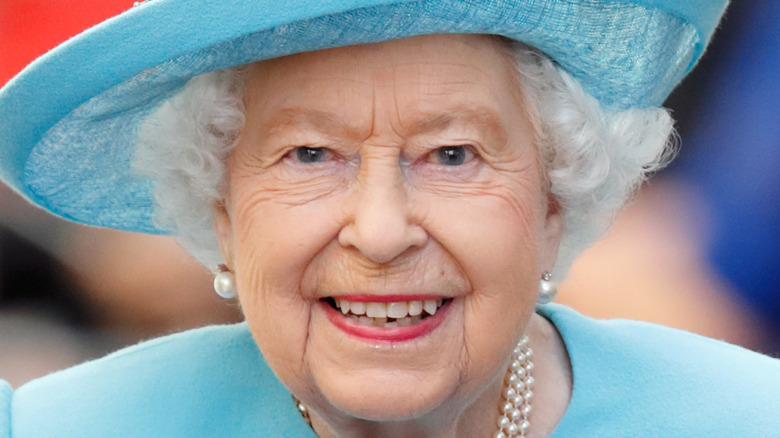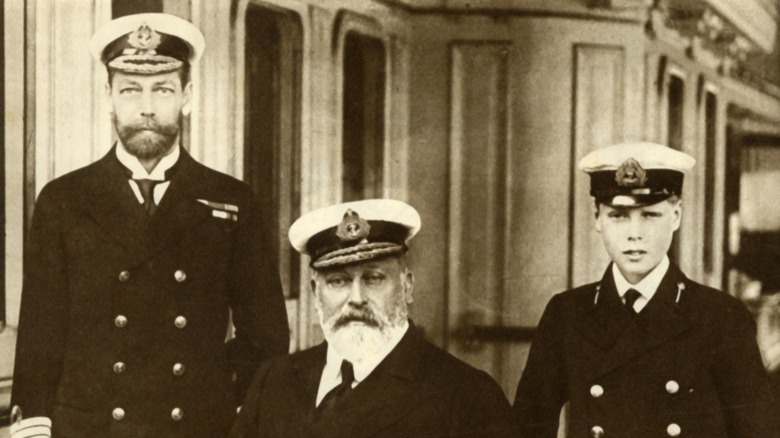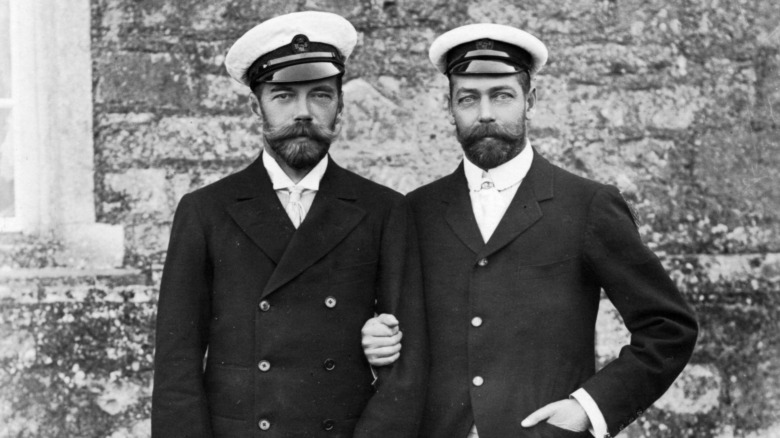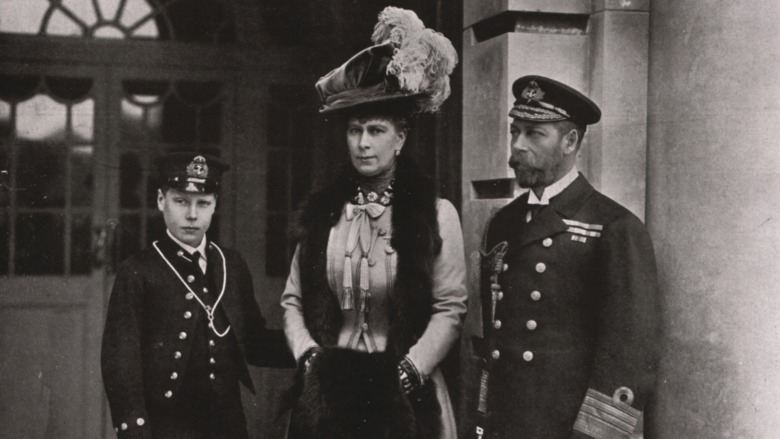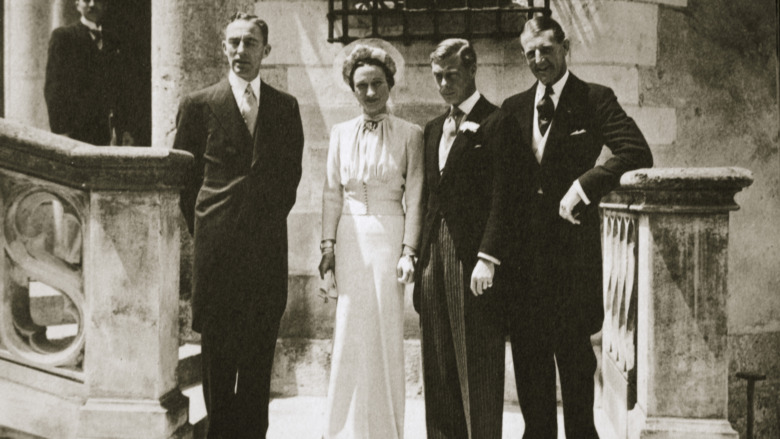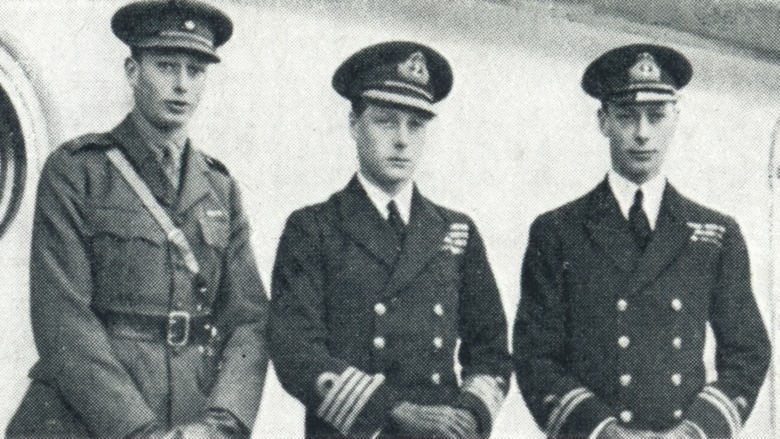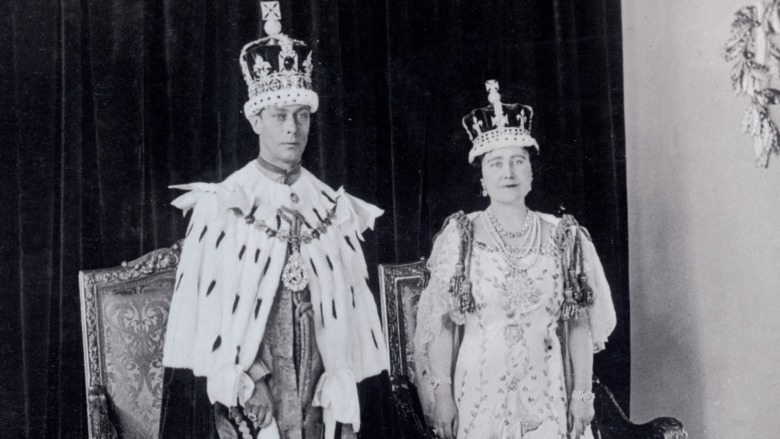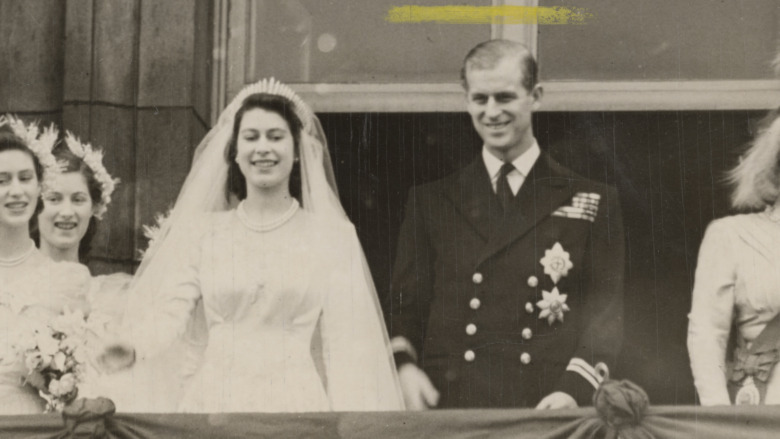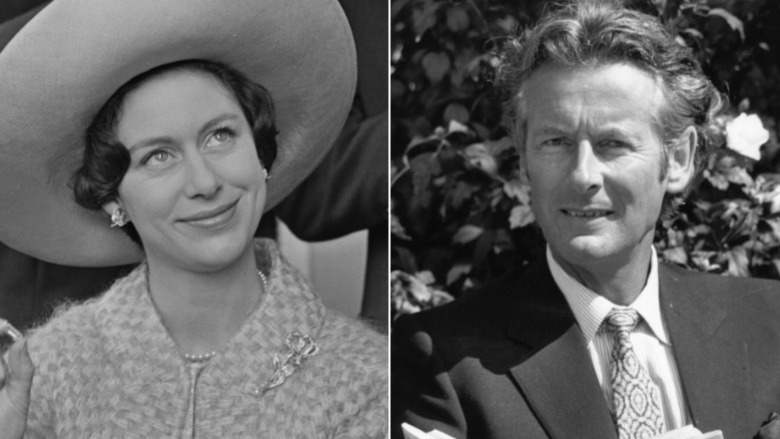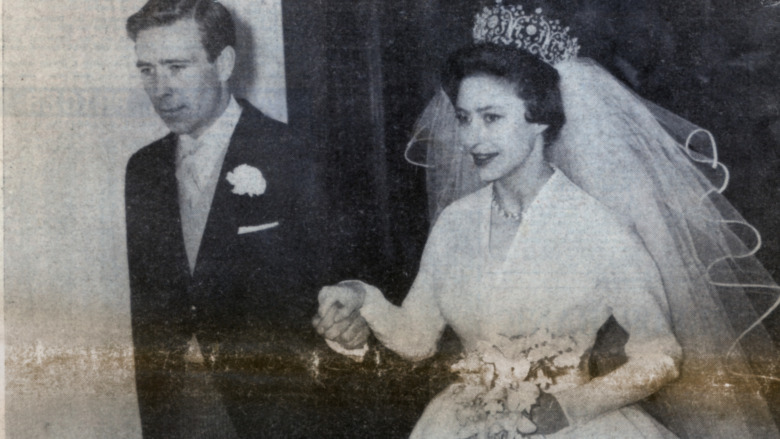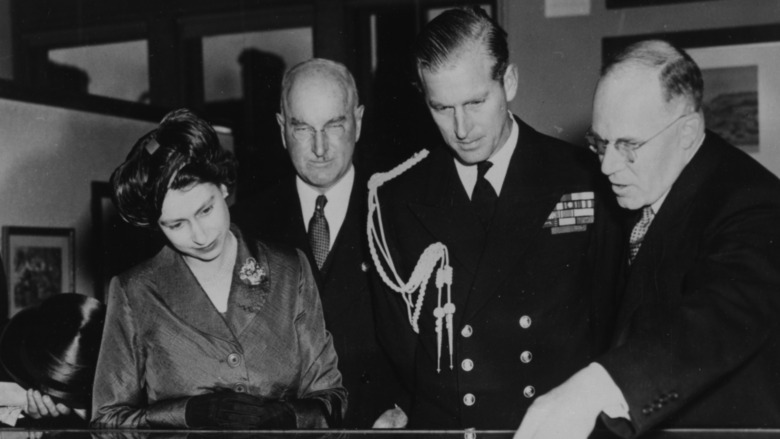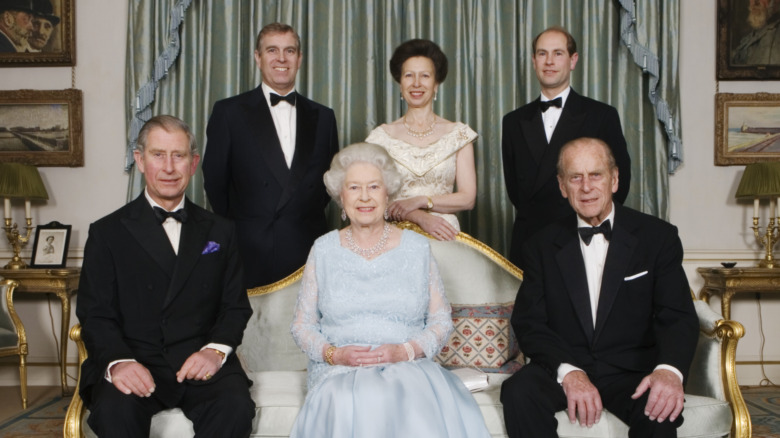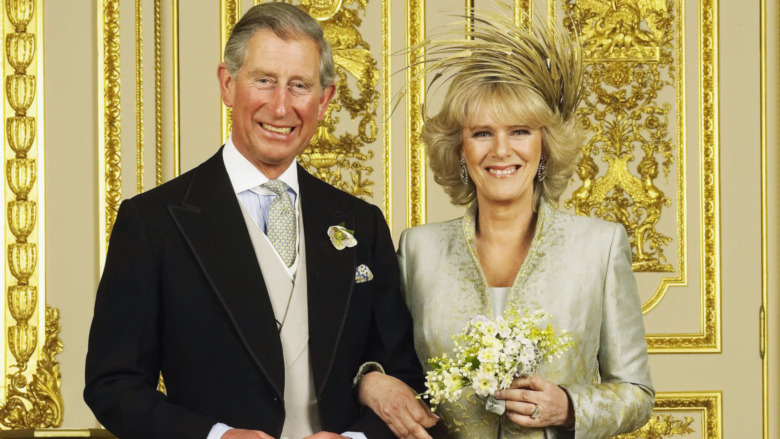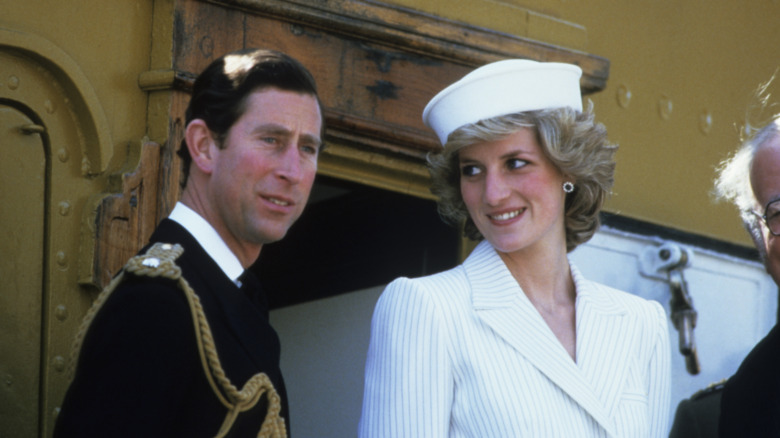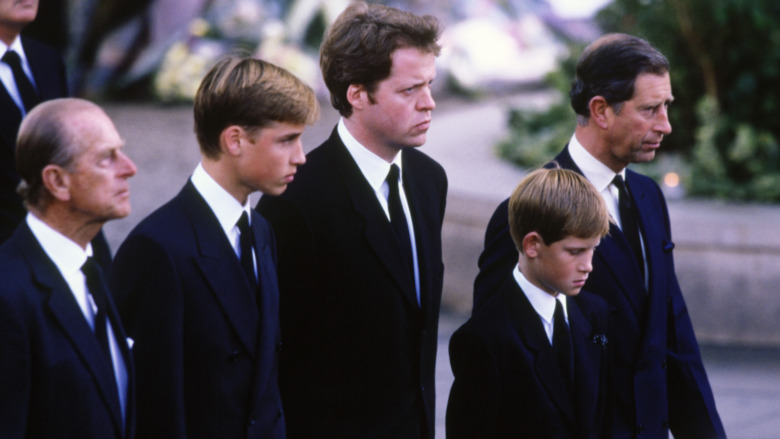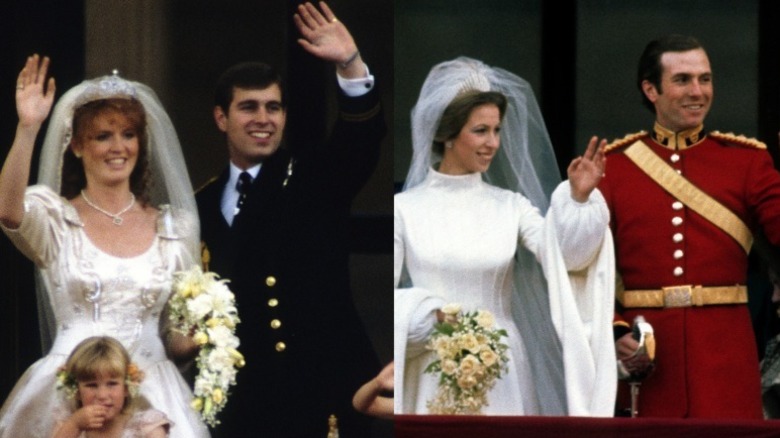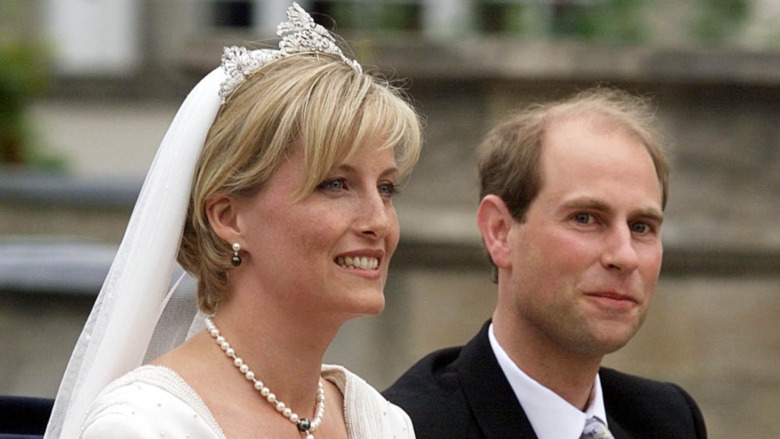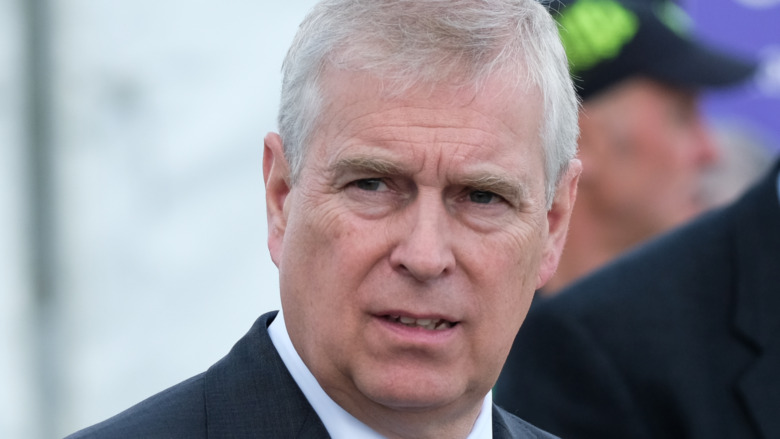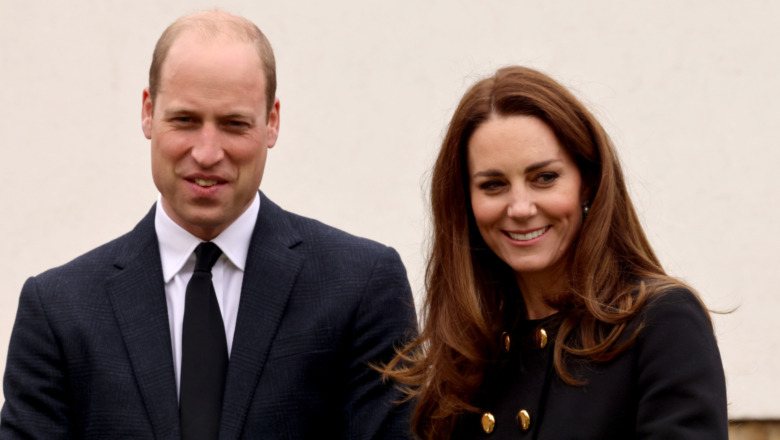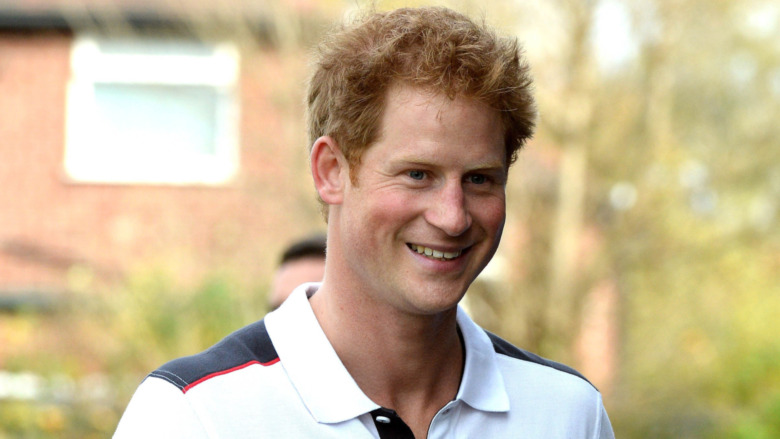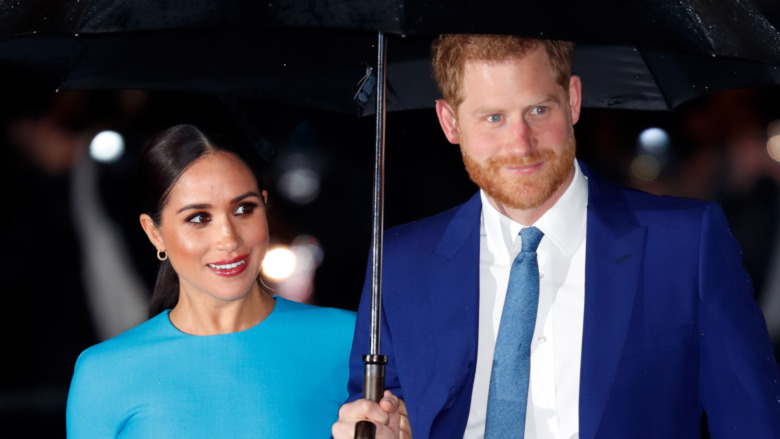The Dark Truth Of The Royal Family
The British royal family has always been the object of fascination for many around the world. They live a glamorous life filled with sparkling jewels, gigantic houses, and aristocratic affairs. While a few other European monarchies have survived into the 21st century, not many have the power of the British royal family. They have weathered modernization and increased calls for their dissolution throughout the years, much to the chagrin of certain anti-royalists across the United Kingdom.
But like many who are thrust into celebrity, the family has not been without its own fair share of scandals. In fact, it was a choice to avoid a scandal that led to the creation of the current House of Windsor in 1917. That decision to ensure the house's survivability through World War I seems to have colored the history of the family throughout the years. Let's take a look at the royal family's darkest secrets.
Windsor was not the family's original name
Royals of most countries do not get surnames; rather, they take on the name of their house, known only as "first name of House blank," like King Henry of the House Tudor. While modern historians tend to equate a house name with someone's surname, that was not actually how royals were named until King George V of House Saxe-Coburg-Gotha made a proclamation in 1917 to adopt the name Windsor (via The Guardian). He also declared that Windsor should be the surname of "all descendants in the male line of Queen Victoria, who are subjects of these realms, other than female descendants who marry or who have married," per the royal family's official website. For the first time, royal family members would officially have a surname. But why the change?
What many people may not know is that the current British monarchy isn't really British at all — rather, they're predominantly German. Due to anti-Catholic sentiment in the 18th century, Queen Anne's distant German cousin, George I, became king of Great Britain upon her death and the founder of the House of Hanover, according to the BBC. This house lasted until Queen Victoria's death. When World War I broke out, as a way to weather the anti-German mentality of the British population, King George V decided to change the family's name to Windsor, named after Windsor castle, as detailed on the royal family's website.
George V's inaction led to the massacre of Tsar Nicholas II and his family
Tsar Nicholas II, his wife Alexandra, and their five children, collectively known as the Romanovs, were brutally executed in a well-known event as a result of the Russian Revolution. But 15 months had passed since Nicholas had abdicated as emperor and he had relations all over Europe as a result of Queen Victoria's many children, as described by History. Couldn't their deaths have been avoided?
In fact, they probably could have been, if the politics of Europe had been a bit different. As it stood at the time, the complications of alliances and World War I caused Nicholas' relations to not act, thereby leading to his death. And King George V — Nicholas' cousin — was among them. But his inaction was almost worse than any of his other cousins', because Great Britain initially agreed to grant the Romanovs asylum before withdrawing it due to concerns about alienating the new Russian government, a concern shared by his other cousins, reported History. However, George actively campaigned against giving aid to Nicholas and his family, apparently fearing pushback by the British people if he invited "Bloody Nicholas" into their country. He had to make a choice — save his cousin, or save his monarchy. And in a move that would come to signify his reign, George chose duty over family.
George V's son, Edward VIII did not want to be king, and his father agreed
Another way King George V chose duty over family concerned his eldest son, King Edward VIII. Edward was incredibly popular as the Prince of Wales but did not enjoy the same popularity among "government officials and royal courtiers," described Biography. But whereas those officials and courtiers generally kept their concerns to themselves, Edward's father, George, did not. In fact, George allegedly said that "he hoped his eldest son would never have children" so Prince Albert could reign, instead. As his health began to falter, George expressed his thoughts to then-Prime Minister Stanley Baldwin about what type of king Edward would be. "After I am dead, the boy will ruin himself in twelve months."
George's opinion of his son wasn't unique and wasn't altogether disliked by Edward himself. Although the Prince of Wales enjoyed the privileges his station afforded him, he did not like the pressures being the future monarch put on him — opinions he expressed in his personal letters. "I am so heartily sick of being cheered and yelled and shrieked at ... I suppose the fact of the matter is that I'm quite the wrong person to be Prince of Wales," he wrote in a letter to his sister (via Express). Historian Dr. Piers Brendon agreed, saying, "[Edward's] letters ... are extraordinary in the way he expresses his hatred of the life that he's leading."
Edward VIII's abdication
One of the most notable scandals of the House of Windsor involves King Edward VIII and his abdication, or his stepping down from being king. Edward's decision was important because he was the first English monarch to remove himself from power voluntarily, reported History. The public story is that Edward abdicated for love, choosing family over duty, unlike his father. He had fallen in love with Wallis Simpson and wanted to marry her; the problem was, she was a divorcée.
Since the British monarch is also the head of the Church of England, he could not marry a twice-divorced woman, as divorce was against the church's doctrine. Initially, Edward proposed a compromise, where he would marry her, but she wouldn't receive the title of queen, and their children wouldn't be able to inherit the throne. But that suggestion was rejected by the British government, reported Vogue.
The real story of why Edward's compromise was rejected might be a bit more sinister, however. Edward's anti-monarchist sentiments weren't a secret to government officials, nor were his sympathies to right-wing authoritarians, as expressed in The History Press. Edward's lack of discretion was also concerning, as he allegedly left out sensitive documents for Italian and German diplomats to see, people whose governments were directly opposed to British interests. Edward's "state of mind" was also questioned, so his abdication was probably met with relief by the government.
George VI removed Edward VIII from the line of succession and effectively exiled him
When George VI became king, he had a decision to make — what to do with Edward VIII. Technically, abdication meant Edward would no longer be in the line of succession nor supported by the government. But this situation was unprecedented, as the last time a British monarch was deposed (James II in 1688, per The History Press), he never formally renounced power, and essentially two different courts formed within England.
Trying to avoid that — and Edward running for a position in the House of Commons — George bestowed a dukedom on him, creating the position of the Duke of Windsor as his first act as sovereign, as detailed in an account of George's speech to Parliament published in The London Gazette. Edward and Wallis Simpson married in France, and made that country their home for the next two years (per History).
However, Edward and Wallis had Nazi sympathies, and he met with Adolf Hitler in 1937. Once France fell to the Germans, Edward and Wallis escaped to Spain, but they weren't safe just yet. According to History, Edward was a target of a Nazi plot to kidnap him and install him as a puppet leader of Great Britain. Prime Minister Winston Churchill didn't know about the plot, yet he was aware of Edward's thoughts about the Nazis, so he installed the former king as the governor of the Bahamas to keep him out of the European conflict.
George VI had a difficult reign
It's not a stretch at all to say that George VI had a difficult reign. He not only took over the monarchy in a non-traditional way, he then had to guide his country through what could be argued as the most difficult time period in modern history — World War II. He performed admirably though, with his wife at his side, and stayed in Buckingham Palace in London when the city was bombed. But the war affected more than just England. Most notably, World War II saw a push for greater independence from other members of the British Empire.
The path to independence for countries like India and Palestine had already been paved with the Balfour Declaration in 1926 and was further solidified after the end of World War II. India gained independence in 1947 and the London Declaration of 1949 saw the formation of the Commonwealth of Nations, effectively ending the British Empire after more than 200 years, as described on the Commonwealth's official website.
The stresses of the war and the dissolution of the empire eventually led to the premature death of George. He smoked almost constantly as a result of his speech impediment, and "developed lung cancer and ... a circulatory ailment," reported Time. Although he underwent surgery to remove his left lung in 1951 (per Biography), his health eventually failed him, and he died at only 56 years old.
Elizabeth II's marriage to Prince Philip was not without controversy
Queen Elizabeth II and Prince Philip were married for over 73 years, but if her parents had their way, she would have married somebody else (via Express). Sir Edward Ford, a courtier of the royal household, said the Queen Mother had "produced a cricket eleven [possible suitors] and it's hard to know whom she would have sent in first, but it certainly wouldn't have been Philip."
Although Philip's royal pedigree was intact — in fact, as the son of a prince and princess, Philip had more royal blood than Elizabeth, whose mother was just a noblewoman (via Vanity Fair), many parts of his life were concerning, most notably his German heritage. Not only was his maternal grandfather fully German, but his four sisters had also all married German aristocrats with "Nazi links," reported Express. Philip was also penniless — his father had been exiled from Greece when the monarchy was overthrown, so some courtiers thought he just wanted Elizabeth's money.
Although the princess wouldn't be dissuaded from marrying the man she loved, having a wedding in 1947 was not easy. She had to consider Britain's post-war economy and politics. For example, she couldn't invite Philip's sisters to the wedding due to their Nazi connections and she had to pay for the silk to make her dress with ration coupons, as revealed by Town and Country.
Princess Margaret was not allowed to marry her first love
Princess Margaret, Queen Elizabeth's younger sister, fell in love with Peter Townsend, an equerry to the royal family. However, after serving overseas, he married Cecil Pawle, though the two got divorced after Pawle had an affair, per Town and Country. Unfortunately, due to the Royal Marriages Act of 1772, the monarch had to approve of all marriages of royals in the line of succession under 25 (Margaret was 23 at the time). While Elizabeth didn't disapprove of her sister's intended, under pressure from the government and the Church of England, she did not consent to the marriage because of Townsend's divorce (reported the BBC).
Margaret then decided to wait two years until she was over 25. However, she would have had to persuade Parliament to allow her marriage, which would have caused sheer chaos. Instead, a compromise was reached, allowing Margaret to marry Townsend and maintain her position in the royal family, but be removed from the line of succession.
Three days after the change to the Act was proposed, however, Margaret decided not to go through with the marriage. Although she never said why she made that choice, a "clue may come in a letter" that the princess gave to Prime Minister Anthony Eden. In her own words, she said "It is only by seeing him ... that I feel I can properly decide whether I can marry him or not," which may indicate her desire to marry Townsend was less than it seemed.
Princess Margaret was the first senior royal to get divorced in over 400 years
Following the news that Peter Townsend was getting married to someone else, Princess Margaret accepted a proposal from photographer Antony Armstrong-Jones in 1960. Their romance was kept secret until they announced their engagement, and their wedding helped "break down Britain's strict class barriers," as Armstrong-Jones was a commoner (per History). Theirs was also the first royal wedding to be broadcast on television, attracting over 300 million viewers, reported Express. On the outside, they led a fabulous life of parties and social engagements, but privately, their marriage was anything but perfect.
According to Town and Country, Armstrong-Jones' ideal marriage was quite different from Margaret's and he spent more time with his job than with her. Shortly after the birth of their second child, he began a series of affairs, which led Margaret to engage in her own infidelity. Eventually, Margaret's relationship with Roddy Llewellyn, a landscape gardener who was 18 years younger than her, led the princess to go public with her marriage difficulties. Margaret and Armstrong-Jones separated in 1976 and divorced in 1978, "the first in the royal family in 400 years" (via Biography). Although Armstrong-Jones remarried, the two remained friends throughout their lives.
Elizabeth II was almost assassinated a few times
Although Queen Elizabeth II is not involved directly with the politics of the Empire, as covered by The Guardian, she has dipped her toe into the affairs of the Commonwealth a few times. Most notably, she has made her opinions known about Brexit and the Scottish Referendum for Independence. While she tries to maintain her neutrality, she has still come under fire from her detractors — sometimes literally. In fact, Elizabeth has been the target of a few different assassination attempts throughout her almost 70-year reign. A few of these hadn't been made public when they occurred, so even more incidents might have happened that aren't yet known.
The first publicly known attempt on the queen's life happened when she was visiting Australia in 1970, as detailed by Biography. She was taking a train from Sydney to New South Wales when a log was placed on the tracks with the intention to derail it. Luckily for the queen, who was traveling with Prince Philip at the time, the driver was able to pull the brakes and stop in time. She was also the focus of two shootings that both took place in 1981, just months apart. One occurred in London and the other in New Zealand and both were carried out by 17-year-old boys. Neither were true threats to the queen, as the boy in London only fired blanks, and the one in New Zealand was too far away for his bullet to reach her.
Elizabeth II was not the warmest mother
In 1947, Elizabeth II gave a speech on her 21st birthday where she promised to devote her "whole life ... to your service and the service of our great imperial family to which we all belong," per the royal family's official website, and it seems she has been following that mantra since then. Even motherhood didn't take her away from her duties to the country. Prior to becoming queen, however, Elizabeth had already chosen to spend time with her husband over her children. Prince Philip had been given an assignment for the Royal Navy in Malta, causing Elizabeth to leave Prince Charles a mere six days before his first birthday to join Philip in the Mediterranean, per Vanity Fair. She returned to London when she was pregnant with Princess Anne and gave birth to her there. Soon after Charles' second birthday, she returned to Malta to be with Philip again.
But George VI's failing health required her to take on more of her father's duties, and Elizabeth and Philip soon left on a 35-day journey to North America, missing Charles' third birthday. Upon returning to Liverpool, Elizabeth joyously hugged her mother, while only giving her son a quick kiss on his head. "Britain's heiress presumptive puts her duty first," Vanity Fair reported a newsreel announcer said at the time. That dedication to duty only extended when she became queen. "She was not indifferent so much as detached," Charles' official biographer, Jonathan Dimbleby, wrote in 1994 (via Vanity Fair).
Prince Charles' complicated relationships
It's no secret that Prince Charles had a tumultuous romantic life. According to Town and Country, the royal has allegedly been linked to "dozens" of women while he was single, during his marriage to Princess Diana — and after. As the outlet notes, the royal family has denied all of this. Most notably, he was linked to a few nobles, like Lady Jane Wellesley, wealthy heiress Sabrina Guinness, actress Susan George, and even Barbra Streisand. None of the romances lasted long, however, except for his ongoing one with Camilla Parker-Bowles (née Shand).
Camilla and Charles first met in 1970, when she was still in a tumultuous relationship with Andrew Parker Bowles (via Town and Country). Although Camilla was "dying for [Charles] to propose," he apparently wasn't ready to settle down and was unwilling to marry her before departing on his naval service. She was also considered to be unsuitable to marry Charles, so she accepted a proposal from Andrew while the prince was overseas. The marriage apparently "devastated" Charles, but he still maintained a friendship with her.
According to "Prince Charles" by Sally Bedell Smith, Charles had begun an affair with Camilla in 1986. They kept their relationship private, but Diana confronted Camilla in 1989, reportedly telling her she knew what was going on between her and Charles. The affair became public in 1993, when a secretly recorded explicit conversation between the two leaked to the press.
Prince Charles and Princess Diana get divorced
Even though Prince Charles was in love with Camilla Parker-Bowles, her marriage meant he had to find somebody new. He met Princess Diana in 1977, when she was just 16 years old, according to biographer Sarah Bradford's "Diana." Charles spent some time with her over the next few years, but didn't propose to her until 1981, and only at the urging of his father. While their marriage was publicly happy, privately, Diana disliked the closeness of Charles and Camilla.
Diana also said she was depressed and attempted suicide multiple times, according to biographer Andrew Morton in his book "Diana: Her True Story." Though Charles and Diana had many issues in their marriage, Diana claimed she knew their exact breaking point was in 1984. "[Charles and I] were very, very close to each other the six weeks before Harry was born," Diana reportedly told Morton, adding, "Then, suddenly, as Harry was born, it just went bang, our marriage. The whole thing went down the drain."
Rumors of infidelity on both sides of the marriage filled the pages of the tabloids thereafter, most notably "Camillagate" in 1993, where information about Charles' affair became public. According to Mirror, Charles and Diana separated one month later. Charles admitted his indiscretions in a 1994 documentary. Diana confessed to her own affair with Captain James Hewitt in a bombshell 1995 interview with BBC's Panorama. That interview was reportedly the last straw for Queen Elizabeth, who then urged the embattled couple to divorce, which they did, making official in August 1996.
Elizabeth II's apparently lackluster response to Princess Diana's death
On August 31, 1997, Princess Diana died in a car crash while visiting Paris. In the days that followed, Queen Elizabeth II's apparent lack of empathy angered the public, who thought she should have immediately returned to London to publicly mourn. Additionally, she received backlash for not lowering the Union Jack over Buckingham Palace to half-mast in tribute, reported the Mirror. However, the real reason she didn't immediately address Diana's death was much more compassionate.
"This was the first time in a long reign that the Queen was thinking about her family before her people," Tina Brown, author of "The Diana Chronicles" wrote, via the Mirror. Elizabeth was apparently concerned about her grandsons and "the Queen and Prince Philip did all they could to help the young princes" in the days following Diana's death. The queen also allowed the government to break protocol, letting the flag fly over Buckingham Palace at half-mast even though she wasn't there.
The queen also reportedly wouldn't permit Prince Charles to take "the royal flight to Paris" to retrieve Diana's body, Richard Kay said, via the Mirror. But the prince allegedly fought hard to get permission to go and the queen eventually backed down. "Charles fought harder for Diana than he had ever fought for her in her lifetime," Kay stated. Elizabeth eventually returned to London to observe the makeshift memorial for Diana, but her choice of privately handling the matter caused her popularity to decline for a few years.
Prince Andrew and Princess Anne also divorce their spouses
The divorce of Princess Margaret in 1978 seemed to indicate a fundamental shift in how the royal family and the British press viewed marriage and divorce. When Princess Anne's unhappy marriage to Captain Mark Phillips appeared irreparable, Queen Elizabeth II reportedly "quietly [orchestrated] the timing and tenor of the announcement," according to People. She also made Anne's new lover, Commander Timothy Laurence, a "member of the Royal Victorian Order," tacitly showing her support for her daughter's new relationship. The press also didn't seem to vilify Anne, "signal[ing] a more tolerant view of divorce within the royal family."
Anne and Mark separated for two years "to avoid a court explanation," per People, and officially divorced in 1992. That same year, Anne married Timothy, and the two are still together as of this writing. Mark, on the other hand, married as well, but he and his new wife divorced due to infidelity on his part. He is currently in a relationship with the woman he cheated on his second wife with.
1992 was a busy year for the royal family, as it also saw the separation of Elizabeth's second son, Prince Andrew, and his wife, Sarah Ferguson, reported Town and Country. Although the two wouldn't officially divorce until 1996, inappropriate pictures of Sarah with an American businessman caused her to lose her standing within the royal family. Unlike Anne and Mark, however, Andrew and Sarah enjoy a close friendship still and neither has remarried.
Prince Edward's unique title
Prince Edward, the youngest son of Queen Elizabeth II and Prince Philip, had a different experience receiving royal titles than his brothers. As the oldest son of the monarch, Prince Charles became Duke of Cornwall when his mother ascended to the throne. Prince Andrew became Duke of York upon his marriage to Sarah Ferguson. Even Prince William and Prince Harry were granted dukedoms upon their weddings. When Edward married, however, he was made an earl, breaking "a centuries-old tradition that children of the monarch were created Dukes upon marriage," reported Royal Central. There is a specific reason why that was the case and why his children are not styled prince and princess, however, even though the Letters Patent of 1917 indicated that all grandchildren of the male children of the monarch would automatically be styled "HRH."
The Telegraph reported that Edward actually requested the title Earl of Wessex, taken from a character from "Shakespeare in Love." Per Royal Central, it was also announced Edward's children would "be styled as children of an Earl," rather than "HRH."
This will not last forever, however. The Sunday Times confirmed that, upon Philip's death, the Duke of Edinburgh title would be bestowed upon Edward, thus elevating him to the status of duke. This arrangement was said to be made to honor Edward's closeness with his parents, and the assistance he gave Philip later in life.
The scandal of Prince Andrew
In 2019, Prince Andrew caused yet another scandal for the royal family. This one, however, was so troublesome that Andrew voluntarily stepped down from public duty as a royal. The cause? Andrew's friendship with convicted sex offender Jeffrey Epstein.
Although Epstein died before he stood trial for charges brought against him in 2019 of sex trafficking and conspiracy to engage in sex trafficking, he had already pleaded guilty in 2008 "to a felony charge of socilictation of prostitution involving a minor," reported The Wall Street Journal. Following Epstein's release from prison, he and Andrew were photographed walking together in Central Park, and video emerged (as seen in the Daily Mail) of Andrew spending time in Epstein's NYC house. Following Epstein's death, his court records were unsealed, and Andrew was one of the alleged abusers named. One of Andrew's alleged victims, Virginia Roberts Giuffre, spoke with Today's Savannah Guthrie and called the prince "an abuser."
In answer to these allegations, Andrew sat down with Emily Maitlis of BBC News for what Town & Country described as a "no holds barred" interview regarding his relationship with Epstein and denied Giuffre's allegations. However, "[Andrew] did not explicitly express sympathy for Epstein's victims," Town & Country noted. A few days after the interview aired, Andrew announced he was stepping away from royal duties and has rarely been seen in public since. It's worth noting, however, that Andrew refused to cooperate with United States officials in the Epstein investigation.
Prince William doesn't get along with the press
The royal family is constantly scrutinized and in front of cameras, which can be a tough environment in which to grow up. This relationship with the press was even more difficult for Prince William and Prince Harry, whose mother, Princess Diana, was killed in a car crash while trying to escape the paparazzi. William has gone on record, describing just how much the media attention affected his mother. "I believe she cried more to do with the press intrusion than anything else in her life," he said in the BBC documentary "Diana, 7 Days," via Vogue. "She was subjected to treatment that, frankly, nowadays people would find utterly appalling."
Growing up that way undoubtedly shaped the princes' relationship with the press, so much so that William asked them in 2007 to leave his then-girlfriend Kate Middleton alone, reported Metro. "What Prince William wants more than anything is for the paparazzi to stop harassing [Kate]," a spokesperson for the prince said at the time.
That ask of the press laid the groundwork for an eventual lawsuit William and Kate filed against the French publication Closer, which posted topless photos of the Duchess of Cambridge when they were on vacation in the south of France. Vogue reported that, after five years and a lengthy court process, the judge ruled in favor of the royal couple in a "watershed moment for Kate and William, [and] the entire royal family and the press that chronicles it."
Prince Harry was the 'party prince'
It's no secret that Prince Harry has had his fair share of scandals throughout his years growing up, so much so that he was often called the "party prince" (per Vogue) and is known to be much "wilder" than his brother, Prince William, reported The New York Times. Although Harry has had his fair share of partying incidents — including the time he was photographed naked in Las Vegas or when he was caught day-drinking — there are a few more noteworthy moments of his that are worth repeating.
Harry's most notorious scandal, however, was when he dressed up as a Nazi soldier for a party. Per The New York Times, the photos of him in the costume caused significant backlash, with even then-Prime Minister Tony Blair commenting on it. Beyond that, Prince Charles also required Harry to spend a day at a drug rehabilitation facility after he allegedly caught his son smoking marijuana. Harry got into a well-documented scuffle with photographers outside of a London club and has broken royal protocol by kissing his girlfriends in public.
Harry's press was so bad for a time, the Daily Mail reported that Charles hired a "minder" for him "amid concern about ... Harry's singular ability to attract an unhealthy degree of what courtiers call 'the wrong kind of publicity.'" Thankfully, it seems he's calmed down in recent years.
Prince Harry and Meghan Markle's accusations of racism
It's no secret Prince Harry and Meghan Markle had a hard time navigating royal life after they got married. In fact, the situation reached a head when the Sussexes announced they were stepping back from senior royal duties and would live in North America. In 2021, after the decision to step back had been revisited and reaffirmed, Harry and Meghan granted a bombshell interview to Oprah Winfrey, during which they alleged multiple scandalous claims about their treatment by The Firm and the institution that runs it.
One of the most significant revelations, however, was Meghan and Harry's assertion that there was concern about what color skin their children would have. Harry clarified that the statement was said just to him and prior to his marriage to Meghan, but said the conversation "was awkward." While they have refused to name who raised the concern, Oprah did say the Sussexes confirmed the comment did not come from the queen nor from Prince Philip.
Meghan continued, saying the optics were not the best, as Archie Mountbatten-Windsor would be the first British senior royal of color. Not giving him a title seemed like a direct result of his potential "brown" skin, and she said it was "hard ... to see those as compartmentalized conversations." While the royal family has been fairly silent on the issue, Prince William did negate the claims, saying they were "very much not a racist family," per The New York Times.

